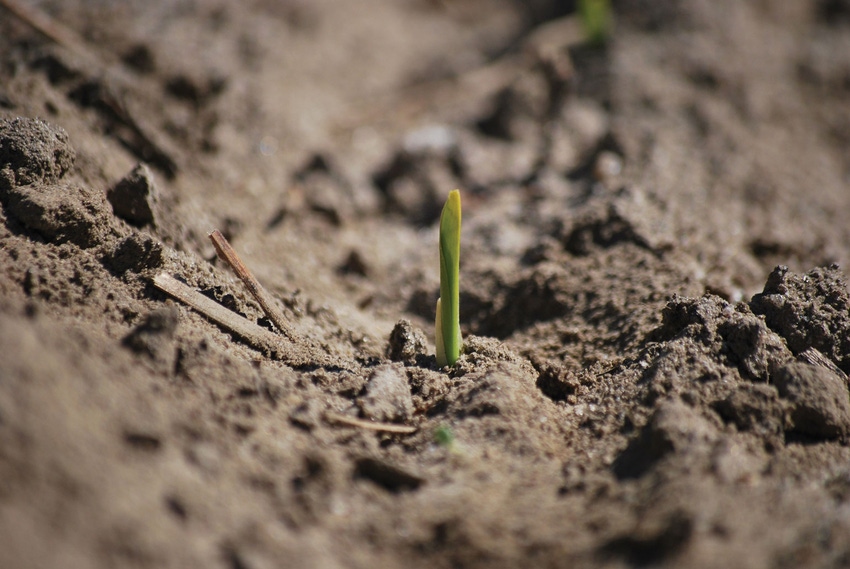October 23, 2020

Springtime weather in the Midsouth is much like that box of chocolates: You never know what you’re going to get as planting begins. Growers who start out with a good disease management plan tend to fair better than those who play catch-up as the season progresses.
In 2019, there were around 740,000 acres of corn harvested in Arkansas. With 70% of the corn used for in-state poultry feed, it is important for farmers to prevent diseases. One of the best ways to beat common diseases is to start off the planting season right.
“[Farmers] will want to let the soil warm up a little bit, and they shouldn’t plant when it’s too wet,” said Jason Kelley, University of Arkansas System Division of Agriculture Extension agronomist — wheat and feed grains. “Planting into cool and wet conditions are more favorable for seedling disease development.”
The planting season usually begins in March and runs through April. Temperatures during this time of year can range from the upper 40s to the lower 80s. This wide gap in temperature can make it difficult for farmers to plan a planting start date, but most farmers try to plant early to maximize yield potential.
“There are certain pathogens that like the cooler weather, so planting when the soil warms up helps eliminate some of those problems,” Kelley said.
Arkansas usually receives 4 to 5 inches of rain in March and April, which can cause a problem during planting season. “Avoid planting in soil that’s too wet, and farmers shouldn’t plant right before a big rain,” Kelley said. “They should also correct any drainage issues that their fields might have, because proper drainage is a huge factor in getting a corn crop off to a good start.”
A good seed treatment can help prevent insect pests along with diseases. “Most of the time, a lower insecticide rate is adequate to control most insect pests,” Kelley said. “It will protect against many of the common soil insects that may feed on corn seed.”
Farmers who utilize cover crops may need to have a higher rate for their seed treatments, as insect pressure may be higher under those conditions. “We recommend a higher seed insecticide rate for fields that incorporate cover crops, because there are usually more insects in those fields,” Kelley said.
Getting corn planted earlier can bring yield benefits later in the season. Southern rust, a common corn disease in Arkansas, does not overwinter in the area. Each year, it is reintroduced by Mother Nature.
“If southern rust comes in later in the season, then farmers who planted early and had mature corn earlier may not need to apply as much fungicide,” Kelley said. “Corn that is planted later typically has a greater need for a foliar fungicide later in the season.”
Soybeans
Soybeans are worth about $1.7 billion annually in Arkansas. According to the University of Arkansas System Division of Agriculture Cooperative Extension Service, diseases can reduce yields by as much as 10% statewide. Individual fields can see rates much higher than this, an extensive impact to soybean’s economic value.
Experts at the University of Arkansas System Division of Agriculture recommend picking the right seeds, and they have the science to back it up.
“We test our varieties every year for different diseases and nematode resistance to try to get as much information out to producers about current varieties as we can,” said Jeremy Ross, soybean Extension specialist for the University of Arkansas System Division of Agriculture.
He said that seed quality has a considerable impact on the prevention of diseases in the early season. “The first step is making sure you have a really high-quality seed with a good seed treatment,” Ross said. “We emphasize a combination of insecticide and fungicide.”
Determining the right seed treatment can decrease the disease rates, and farmers should pay attention to their individual needs to pick the best one for them. “One factor is field history and whether or not they’ve had seedling diseases or other diseases in those fields,” Ross said. “If they have had diseases, then they definitely need seed treatment.”
Ross said that farmers should also take advantage of treatment if they plan on getting a quick start to the season. “If you’re going to plant extremely early, when the soil is cool and wet, then you should absolutely look at seed treatment,” Ross said.
Along with making sure the seed is high-quality, producers need to contemplate which seed variety they will pick. “The herbicide technology that a farmer is going to use throughout the season is what drives seed variety selection,” Ross said. “Once they decide that, they can start looking at disease packages and nematode resistance.”
Disease packages help prevent disease and allow farmers to reduce the amount of fungicides they use. “Varieties that have good, strong disease packages don’t need fungicides, because the plant already has some internal protection,” Ross said.
While fungicides are not widely used with soybeans in the early season, resistance remains a concern for Ross. “Automatic sprays are a big driver for resistance,” Ross said. “If you continually expose those diseases to the fungicides, then they will eventually build up a resistance and be able to survive the application,” Ross said.
You May Also Like




